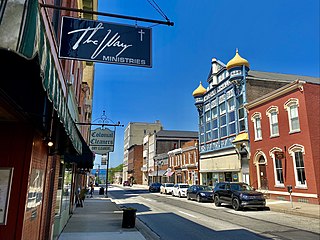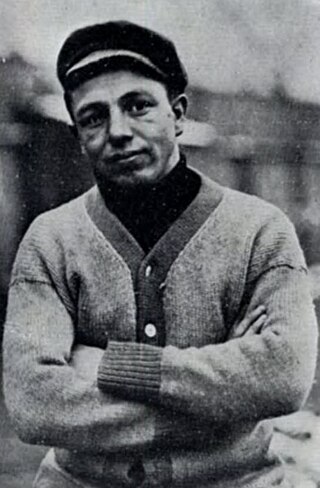
Latrobe is a city in Westmoreland County, Pennsylvania, United States. The population was 8,060 as of the 2020 census. A part of the Pittsburgh metropolitan area, it is located near Pennsylvania's scenic Chestnut Ridge. Latrobe was incorporated as a borough in 1854, and as a city in 1999. The current mayor is Eric J. Bartels.
The Akron Pros were a professional football team that played in Akron, Ohio from 1908 to 1926. The team originated in 1908 as a semi-pro team named the Akron Indians, but later became Akron Pros in 1920 as the team set out to become a charter member of the American Professional Football Association. Fritz Pollard, the first black head coach in the NFL, co-coached the Akron Pros in 1921. Paul Robeson played for the team in 1921 as well. He was among the earliest stars of professional football before football became segregated from 1934 to 1946. In 1926, the name was changed back to the Akron Indians, after the earlier semi-pro team. Due to financial problems, the team suspended operations in 1927 and surrendered its franchise the following year.
Walter Rufus East was a minor league baseball player active between 1903 and 1912. As a second baseman he played for various in the Southern Association, Eastern League, Missouri Valley League, Ohio State League and the Ohio–Pennsylvania League. East however also managed several minor league teams from the Ohio–Pennsylvania League.
Harry Addison March was an early football historian and promoter, as well as a medical doctor. He also helped organize the National Football League (NFL) and well as the second American Football League (AFL). March is also credited with convincing Tim Mara to purchase an NFL franchise for New York City, which is still in existence today as the New York Giants. He wrote one of the first books on the history of the professional game: Pro Football: Its Ups and Downs in 1934. Dr. March is known as the "Father of Professional Football."
The Latrobe Athletic Association was a professional football team located in Latrobe, Pennsylvania, from 1895 until 1909. A member of the unofficial Western Pennsylvania Professional Football Circuit, the team is best known for being the first football club to play a full season while composed entirely of professional players. In 1895, team's quarterback, John Brallier, also became the first football player to openly turn professional, by accepting $10 and expenses to play for Latrobe against the Jeannette Athletic Club.

John Kinport "Sal" Brallier was one of the first professional American football players. He was nationally acknowledged as the first openly paid professional football player when he was given $10 to play for the Latrobe Athletic Association for a game against the Jeanette Athletic Association in 1895.
The Pittsburgh Athletic Club football team, established in 1890, was based in Pittsburgh, Pennsylvania. In 1892 the intense competition between two Pittsburgh-area clubs, the Allegheny Athletic Association and the Pittsburgh Athletic Club, led to William (Pudge) Heffelfinger becoming the first known professional football player. Heffelfinger was paid $500 by Allegheny to play in a game against Pittsburgh on November 12, 1892. As a result, Heffelfinger became the first person to be paid to play football. Allegheny would go on to win the game, 4–0, when Heffelfinger picked up a Pittsburgh fumble and ran it 35 yards for a touchdown. In 1893, Pittsburgh again made history when it signed one of its players, probably halfback Grant Dibert, to the first known pro football contract, which covered all of the team's games for the year.
The Canton Bulldogs–Massillon Tigers betting scandal was the first major scandal in professional football in the United States. It refers to a series of allegations made by a Massillon, Ohio newspaper charging the Canton Bulldogs coach, Blondy Wallace, and Massillon Tigers end, Walter East, of conspiring to fix a two-game series between the two clubs. One account of the scandal called for Canton to win the first game and Massillon was to win the second, forcing a third game—with the biggest gate—to be played legitimately, with the 1906 Ohio League championship at stake. Another account accused Wallace and East of bribing Massillon players to throw a game in the series. Canton denied the charges, maintaining that Massillon only wanted to damage the club's reputation. Although Massillon could not prove that Canton had indeed thrown the second game and it remains unknown if there was ever a match-fixing agreement, the scandal tarnished the Bulldogs name and reportedly helped ruin professional football in Ohio until the mid-1910s.

Charles Edgar "Blondy" Wallace was an early professional football player and later convicted criminal during the Prohibition Era. He was a 240-pound, former Walter Camp second-team All-American tackle from the University of Pennsylvania. He also played two years at Peddie Institute, in New Jersey, winning state championships in 1896 and 1897. During his professional playing career he was involved in almost every major event in professional football between 1902 and 1907. Over that timespan he played for the independent Philadelphia Athletic Club, the Philadelphia Athletics of the first National Football League, the "New York" team and the Syracuse Athletic Club in the 1902 World Series of Football, the Franklin Athletic Club and the Canton Bulldogs of the Ohio League. In 2022, he was named one of the 10 inaugural members for the Football Learning Academy's Hall of Honor, which looks to acknowledge deserving icons that are not currently inducted in the Pro Football Hall of Fame.
The Massillon Tigers were an early professional football team from Massillon, Ohio. Playing in the "Ohio League", the team was a rival to the pre-National Football League version of the Canton Bulldogs. The Tigers won Ohio League championships in 1903, 1904, 1905, and 1906, then merged to become "All-Massillons" to win another title in 1907. The team returned as the Tigers in 1915 but, with the reemergence of the Bulldogs, only won one more Ohio League title. Pro football was popularized in Ohio when the amateur Massillon Tigers hired four Pittsburgh pros to play in the season-ending game against Akron. At the same time, pro football declined in the Pittsburgh area, and the emphasis on the pro game moved west from Pennsylvania to Ohio.

George Watson "Peggy" Parratt was a professional football player who played in the "Ohio League" prior to its becoming a part of the National Football League (NFL). Born in Cleveland, Ohio, Parratt played quarterback for the Shelby Blues, Lorain Pros, Massillon Tigers, Massillon All-Stars, Franklin Athletic Club of Cleveland, Akron Indians and the Cleveland Tigers between 1905 and 1916. Parratt threw the first legal forward pass in professional football history while playing for the Massillon Tigers on October 25, 1906.
Edwin Kimmell Wood was an early professional football player for the Latrobe Athletic Association, the Franklin Athletic Club and finally for the Canton Bulldogs of the "Ohio League". He also played on Dave Berry's Western Pennsylvania All-Star team, a collection of early football star players, that was designed to compete with the star-heavy Duquesne Country and Athletic Club on December 3, 1898 at Exposition Park in Pittsburgh. In 1902 he played in the first National Football League for the Philadelphia Phillies. He also played for Franklin when it won the 1903 World Series of Football over the Watertown Red & Black at Madison Square Garden. Wood later became one of the first professional players to catch forward passes when they became legal in 1906.
Dan Policowski was an early professional football player for the Massillon Tigers from 1904 to 1906. Originally from Canton, Ohio, which was the home of the Tigers', rival the Canton Bulldogs, Policowski played end under the alias Dan Riley. He was also known as "Bullet Riley".

William John Laub was the Mayor of Akron, Ohio, 1916–17, and an early professional American football player-coach. Laub was the first head coach of the Canton Bulldogs and a player-coach for the Akron East Ends.
Herman Charles Kerkhoff was a professional American football player from the mid 1890s until 1906.
Sherburne Henry Wightman was a professional American football player-coach in the "Ohio League", which was the direct predecessor to the modern National Football League (NFL). He is best remembered for coaching the Massillon Tigers to an Ohio League title in 1906, over the Canton Bulldogs, which led to accusations of a betting scandal. In 1907, he coached a version of the Massillon Tigers called the "All-Massillons" to another Ohio League title. Prior to his professional career, Wightman played at the college level for the Chicago Maroons, under Amos Alonzo Stagg, and Swarthmore College.
The 1906 Latrobe Athletic Association season was their eleventh season in existence. The team finished 3–1.
American football in Western Pennsylvania, featuring the city of Pittsburgh and surrounding areas, has had a long and storied history, dating back to the early days of the sport. All levels of football, including high school football and college football, are followed passionately, and the area's National Football League (NFL) team, the Pittsburgh Steelers, is consistently one of the sport's most popular teams. Many of the NFL's top stars have come from the region as well, especially those that play quarterback, earning Western Pennsylvania the nickname "Cradle of Quarterbacks".
The Western Pennsylvania Professional Football Circuit was a loose association of American football clubs that operated from 1890 to approximately 1940. Originally amateur, professionalism was introduced to the circuit in 1892; cost pressures pushed the circuit to semi-professional status from about 1920 through the rest of its existence. Existing in some form for 48 years, it was one of the longest-lived paying football loops to operate outside the auspices of the National Football League.
The Canton Bulldogs were a professional American football team, based in Canton, Ohio. They played in the Ohio League from 1903 to 1906 and 1911 to 1919, and the American Professional Football Association, from 1920 to 1923, and again from 1925 to 1926. The Bulldogs won the 1916, 1917, and 1919 Ohio League championships. They were the NFL champions in 1922 and 1923. In 1921–1923, the Bulldogs played 25 straight games without a defeat. This remains an NFL record.





